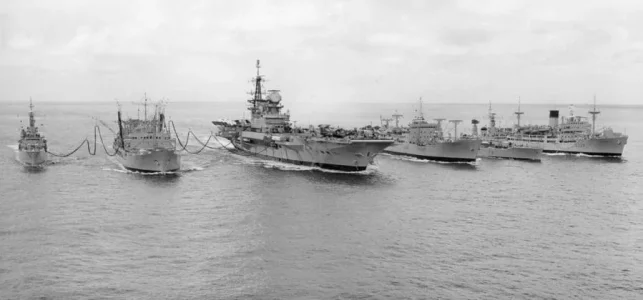USN:
Independence class light aircraft carrier USS Princeton (CVL-23) burning after a Japanese air attack as seen from Cleveland class light cruiser USS Birmingham (CL-62) 24th Oct 1944
Japanese air forces launched a series of counterattacks on 24 October, and during one of these, a
Yokosuka D4Y dive bomber scored a hit on
Princeton that caused serious damage and several large fires;
Birmingham and the three destroyers
Morrison,
USS Gatling (DD-671) and
Irwin remained with the stricken carrier after she fell out of formation. The destroyers initially attempted to come alongside and spray the burning carrier to help the ship's crew suppress the fires, but they repeatedly collided with
Princeton in the heavy seas.
Birmingham then came alongside instead, as her larger hull could better absorb collisions. She sent thirty-eight men and fourteen water hoses over to
Princeton, and they helped the carrier's crew put out one of the two large fires.
Later in the day,
Birmingham received reports of Japanese aircraft approaching, and around the same time, one of the destroyers reported detecting a
submarine just 2,000 yd (1,800 m) away.
Birmingham immediately pulled away from
Princeton so she could evade any incoming attacks. Only one Japanese aircraft actually approached the formation, but it did not attack, and the submarine report was determined to have been a false alarm.
Birmingham then returned alongside
Princeton to resume firefighting, but at 15:22, just as she was coming back alongside
Princeton, the fires reached the carrier's aft
magazines, setting off a catastrophic explosion. The blast destroyed much of the carrier's stern, throwing debris all along
Birmingham's starboard side and inflicting grave casualties among the cruiser's crew.Out of her crew of nearly 1,300, 241 men were killed, 211 were seriously wounded, and 201 received lighter injuries, more than half of the crew. The surviving crew began fighting several fires aboard
Birmingham and treating the survivors, and then she broke off from the stricken carrier. Efforts continued aboard
Princeton, but these ultimately proved futile, and
Reno and
Irwin scuttled her with torpedoes.
Birmingham eventually arrived back at Mare Island in early November for repairs
Casualties on
Princeton herself were relatively light considering the intensity of her fires; 108 men (10 officers and 98 enlisted men) were lost, while 1,361 crewmen were rescued.
Birmingham after arriving at Mare Island, showing damage inflicted by the explosion aboard
Princeton




